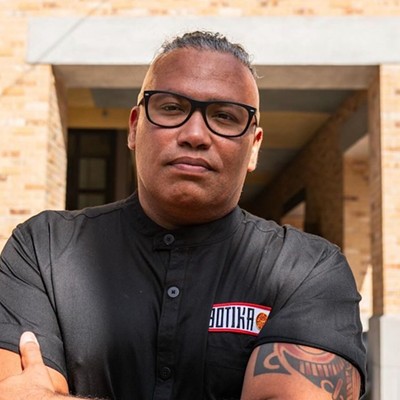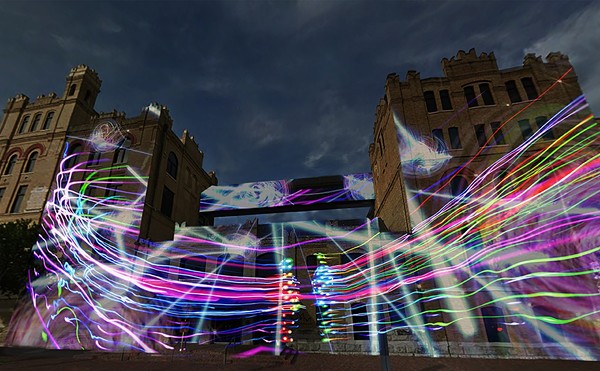|
Schools are on the front line of art materials toxicity and exposure Hiking through the construction site just off Stadium Drive that is the northeastern corner of Trinity University, students and visitors pass the ruins of the Ruth Taylor Art and Music buildings, currently undergoing a wholesale renovation and expansion. On a local scale, the $14 million project demonstrates Trinity's commitment to expanding its fine arts program: In addition to workspaces for painting and sculpture, the 70,000-square-foot facilities will include new studios for photography, printmaking, and digital imaging. On a national level, the project is indicative of the way in which fine arts facilities, and schools that house them, have been forced to change over the past three decades. "It's often a problem, universities don't want to spend a lot of money on studios," says Michael McCann, chemist, art safety consultant, and author of Artist Beware, "so they get stuck away in a basement." McCann, who served as a consultant to Trinity as it planned its fine arts expansion, began writing articles about the potential hazards of art materials in the mid-'70s, after he visited a community printmaking studio where 10-year-old children were taking classes. "Their idea of ventilation was an open window," he recalls, a mode of thinking still practiced in college and university classrooms across the country. It's often hard to convince administrators, doctors, and government officials that there is a threat, McCann says, because "they think, 'Hey, we all played with `art materials` as a kid.'" Despite the Labeling of Hazardous Art Materials Act, passed by Congress in 1988 and largely implemented by 1990, there is relatively little toxicity and safety data available for art materials, as with the majority of chemical products on the market today. "It's a national disgrace," says fellow chemist and art safety consultant Monona Rossol, who is conducting studies with the University of Texas system and Texas Christian University. "The majority of chemicals you come in contact with, there is no data on," including those used in common art mediums such as painting, printmaking, and photography. The relatively small amount of testing that is done, she adds, is for acute, or lethal dose, exposure, rather than for the chronic exposure that is applicable to artists and students. "When you see a safety label, thank the manufacturer," she says, "because that's telling you you've got at least two weeks to live." Rossol, who is also a potter, sits on the art materials subcommittee of the American Society of Testing and Materials, the body that governs labeling of products. In January 2005, she says, she's going to protest putting "non-toxic" on materials for which there is inadequate data. Rossol would prefer a warning that adequate information is not available to determine the safety of a given product. "That would be on just about every art material," she adds. Rossol points up another handicap for the warning system: Toxicologists who review the available materials and make recommendations for labeling are usually paid by the manufacturers. "There's actually a little competition," she alleges, for who can provide the most favorable label. As an example of the scope of the problem, she recounts how, for awhile, ceramic glazes containing lead were labeled not only non-toxic, but lead-free, because the acid solubility test used to determine toxicity did not release the lead. "Well, people are not `just` acid and water!" she says. It wasn't until residents in nursing homes began falling ill that the problem was corrected. McCann, who is working on a third edition of his book (a third edition of Rossol's seminal work, The Artist's Complete Health and Safety Guide, came out in 2001), notes that manuals and practices must keep up not only with new mediums, such as digital print-making and neon lasers, but with new information. "There's been a lot of changes in what's known," he says. For 10 or so years, turpentine was classified as moderately toxic, but now we know that it can be absorbed through the skin, and the acceptable threshold limit value has been lowered from 100 parts per million to 20 ppm, making ventilation and exhaust systems, such as those McCann recommended for Trinity, critical.
Rossol and McCann recount that the Environmental Protection Agency, which began investigating how art departments were disposing of chemicals and then fining violators, prompted colleges and universities to pay attention to the issue. "If you want to find 55-gallon drums and 5-gallon pails" of some of the same chemicals that are closely regulated in chemistry departments, says Rossol, "you go to the art department." And while Occupational Safety and Health Administration rules have applied all along to most state university employees, she says, "I find more schools meeting OSHA once they've been cited by EPA." OSHA rules do not apply to students in most states, but Rossol has acted as a consultant and witness for civil lawsuits by students that she says she can't discuss. "Schools have a procedure ... settle and put on a gag order." In a single year, Rossol claims, she consulted on five cases, three of which proceeded, against a Big Ten university. "If you train and prepare a teacher and don't pass on `that knowledge` to protect a student," says Rossol, you've gone from "negligence to willful and knowing negligence." "From my point of view, you've got to teach the students," agrees McCann, who also emphasizes that there are many less- and non-toxic alternatives available, especially in silkscreening, printmaking, and pottery. He notes that artists who try switching to a less-toxic medium are often initially frustrated with the results but it takes time and experimentation, he reminds them, to reach the same level of skill and technique again. Rossol will return to Texas in October to address the issues that concern the EPA when she presents a paper on the handling and disposal of hazardous art materials at the Texas Campus Safety Association and University of Texas System Risk Management Conference. There are pigments, such as Prussian Blue, and blueprint chemicals that, if disposed of improperly, will violate cyanide regulations, she says. Silver ion, created when used photography chemicals are washed down the drain, is extremely toxic to aquatic organisms. After that it's on to the ASTM in January. "I really hope that people are getting the message," she says. "It's something that will respond well to a little attention." • By Elaine Wolff
|


















